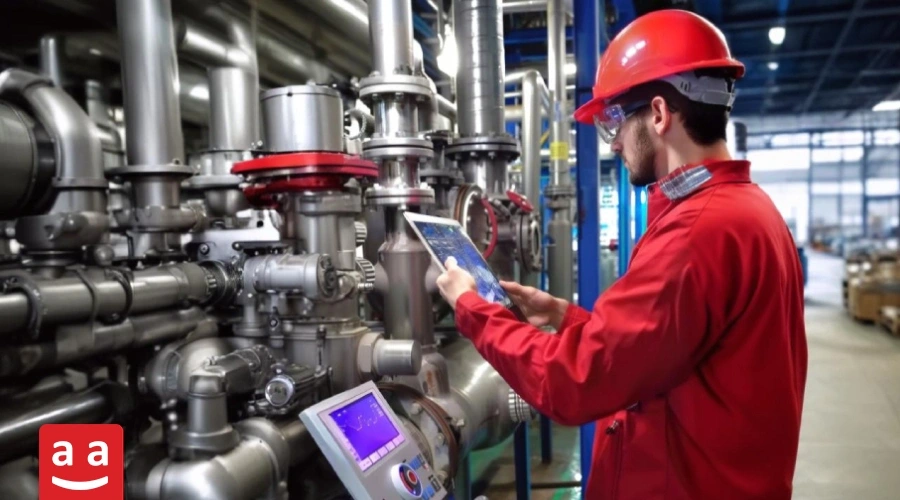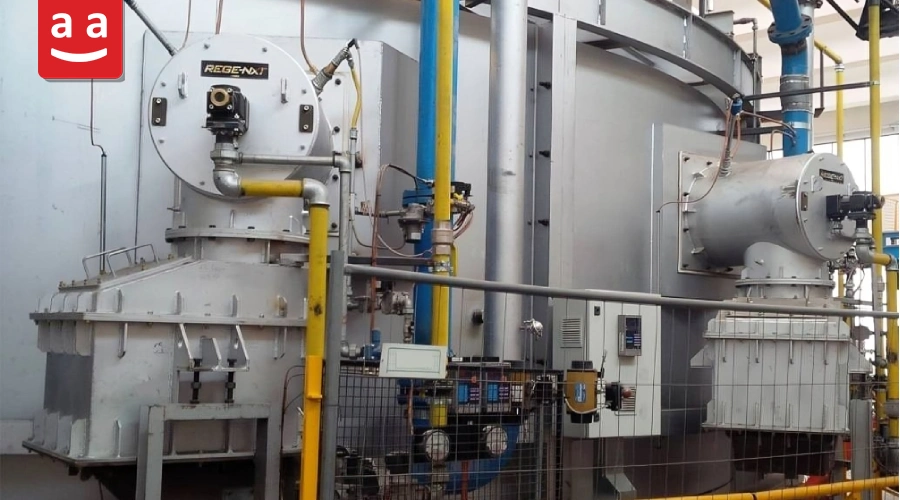Boiler is one of the most important equipment in various industries, used for producing hot water and steam depending on their type. Industrial boilers are widely used in power plants, factories, hospitals, and large buildings. Considering the important role of boilers in industrial operations, protecting boilers to prevent malfunctions and extend their operational lifespan is crucial. Boiler safety systems consist of methods and equipment designed to improve the safety and performance of these devices.
Operating both mechanically and electronically, these systems are designed to prevent accidents, boost efficiency, and ensure the safety of boiler operations. This article will examine the mechanical and electronic systems contributing to boiler safety.
The Importance of Boiler Safety Systems
Boilers are complex and sensitive systems designed to operate under high pressure and temperature. Without proper safety systems, they are susceptible to risks such as explosions, corrosion, and scaling. Boiler safety systems protect internal components, such as pipes, by accurately regulating pressure and temperature while continuously monitoring water quality.
Moreover, boiler safety systems prevent scale formation and corrosion, which helps maintain the boiler’s efficiency. The use of proper boiler safety systems not only extends the lifespan of the equipment but also reduces maintenance costs and significantly improves energy efficiency.
For further information on boiler efficiency, you can read the article “Analysis of Boiler Efficiency and Methods for Its Improvement in Heating Packages “.
Attention to the design and boiler safety systems installation ensures the stable and safe operation of these critical pieces of equipment.
Classification of Boiler Safety Systems
Boiler safety systems are divided into two categories: mechanical and electronic safety systems, both of which are described individually.
Mechanical Safety Systems
Mechanical safety systems are among the components of boiler safety systems, which consist of mechanical equipment that are directly related to the safety and proper operation of the boiler. These systems are designed to monitor, control, and safeguard the boiler against potential risks. Some of these mechanical components include temperature and pressure indicators, safety valves, sight glasses, level controls, and blowdown systems.


Temperature and Pressure Indicators
These devices are among the safety equipment in mechanical safety systems. Temperature and pressure indicators are selected to monitor the internal pressure and temperature of the boiler and provide the operators with essential data. The precision of these indicators is crucial, as any unauthorized fluctuations in pressure or temperature can pose serious risks.
Sight Glass
A further component of mechanical safety systems is the sight glass, which provides a direct view of the boiler’s water level. This equipment helps operators ensure that the water level remains within a safe range and verify the proper operation of the boiler under safe conditions. The water level needs to remain within a specified range, as any changes can cause damage to the boiler or lower its efficiency. By using a sight glass, operators can easily and accurately monitor the boiler’s water level.


Level Controls
Another component of mechanical safety systems is the level control, which is responsible for measuring and controlling the water level in steam boilers. They continuously measure the water level and transfer the data to the control system or operator to ensure that the boiler always has sufficient water. Level controls are vital for boiler safety because a significant drop in water level can cause overheating of the walls or tubes, potentially leading to explosions.
These systems automatically monitor the water level. If the water level drops below the safe limit, the pump and burner are activated. Additionally, if the water level exceeds the safe limit, the pump and burner are turned off. Packman Company uses modulating level controls, including capacitive and conductive types, to achieve precise water level measurement and management in boilers.
Safety Valves
One of the most important mechanical components for boiler safety systems is the safety valve. Its primary function is to maintain safety by preventing excessive pressure. The safety valve is engineered to open and discharge excess steam or water if the boiler’s internal pressure exceeds safe limits. By doing so, safety valves prevent dangerous incidents like explosions and contribute to prolonging the boiler’s operational lifespan. Proper functioning of the safety valve is critical, as malfunction or failure can result in serious hazards. Therefore, regular inspections and proper maintenance of the safety valve are essential for optimal performance. Safety valves are used in both hot water boilers and steam boilers.


Blowdown Systems
Scale formation and sedimentation in boilers are common issues that can lead to reduced efficiency and boiler failure. The blowdown system operates by removing a portion of the boiler water when the concentration of dissolved minerals and chemicals surpasses the permissible threshold. This process may be automatic or require the operator to manually open the blowdown valve to discharge water. The removed water is then replaced with fresh water, ensuring optimal water quality in the boiler and preventing the formation of scale. Blowdown systems are divided into two categories: Top Blowdown and Bottom Blowdown.
Surface blowdown system
One type of blowdown system is the surface blowdown (top blowdown), which is used to control the TDS level (Total Dissolved Solids) in the boiler water. Excessive TDS can result in scale d, corrosion of pipes and equipment, decreased boiler efficiency, and higher maintenance expenses.
To ensure precise TDS monitoring, specialized probes are employed to continuously measure the concentration of dissolved solids in the water and relay the information to the central control system. The Top Blowdown system removes water from the top section of the boiler, eliminating foam and suspended particles that collect on the water surface. This prevents scaling, corrosion, and potential damage to boiler equipment while increasing its operational lifespan. Consistent monitoring and proper utilization of this system guarantee efficient operation and lower operational costs.
Bottom blowdown system
A type of blowdown system, bottom blowdown, refers to the process of draining water from the bottom section of the boiler. It is specifically designed to eliminate heavy sediments and scale deposits that accumulate at the bottom of the boiler due to gravity. The Bottom Blowdown can be conducted in two modes:
- Manual: Conducted by an operator at specific times with direct oversight.
- Automatic: Uses an electric valve and timer to perform scheduled blowdowns automatically.
This approach involves draining water containing waste and sediment from the lowest point of the boiler to prevent sediment buildup, efficiency reduction, and damage to boiler equipment. Accurate monitoring and implementation of this process are crucial for sustaining performance and prolonging the boiler’s service life.


Electronic Safety Systems
A further type of boiler safety system is the electronic safety systems, designed to protect the power and control circuits. These systems include bimetals, load controllers, contactors, fuses, and more. These devices are installed in the boiler’s control panel, which serves as the central unit for managing and safeguarding the power and control circuits. Packman Control Panels (PCP) are among the most advanced electronic control systems available. These panels allow for simultaneous monitoring of the boiler and burner. They offer the ability to adjust and optimize the boiler’s operation, leading to improved efficiency and reduced energy consumption.


Pressure Switch
The pressure switch, which is one of the components of the boiler’s electronic safety systems, controls the flow by turning it on or off when the boiler pressure exceeds or falls below the safe range. If the pressure exceeds the set limit, the device cuts off the system, and if the pressure drops below the allowable level, it restores the system. The correct and timely operation of the pressure switch plays a crucial role in preventing hazards caused by sudden pressure changes and protecting the boiler and its components from damage.
Pressure and Temperature transmitters
These are another safety devices in the electronic safety system. Pressure and temperature transmitters. are used to measure the temperature and pressure in the boiler accurately and send the data to the control system. This data is necessary for assessing and adjusting the temperature and pressure to maintain them within the safe and optimal range for the boiler. In case of sudden changes in pressure or temperature, the transmitter sends immediate warning signals to alert the operator. Therefore, pressure and temperature transmitters are crucial in increasing safety and enhancing boiler efficiency.


Burner and Boiler Controllers
These controllers, as one of the key components of boiler safety systems, play a crucial role in ensuring the safe and optimal operation of these devices. These controllers consist of a set of advanced systems that manage the safe and efficient operation of the burner and boiler. The burner safety system includes safety valves for gas and liquid fuels, flame safeguard, pressure switches, and temperature and pressure sensors. These devices are designed to protect the burner and boiler from potential hazards and enhance the overall performance of the boiler safety systems. The burner controller precisely manages the burner operation by analyzing and combining the signals from this safety system.
The AutoFlame controller is a prominent example of these controllers, capable of optimizing burner management. Additionally, boiler control can be handled by PLCs and micro-modulating controllers. The MK8 M.M micro-modulating controller by AutoFlame and certified with SIL3 safety standards, can simultaneously manage both the boiler and burner while ensuring the boiler’s safety systems comply with global standards.
The advanced burners of raadman Industrial Group and Packman boilers, using AutoFlame controllers, allow for precise management of both the boiler and burner operations. This enhances their performance and helps in preventing the release of harmful pollutants like CO and NOx.
Boiler safety systems, using these controllers and advanced technologies, offer a smart solution for minimizing risks, improving efficiency, and protecting the environment. Emphasizing the importance of boiler safety systems in the design and operation of heating equipment ensures sustainable and safe performance across various industries.


Boiler Safety Systems: An Essential Requirement for Protecting Boilers
Boiler safety systems are a crucial element in ensuring the safe and effective operation of boilers. These systems, which integrate mechanical and electronic technologies, are essential in preventing accidents and enhancing performance. Mechanical safety systems, including safety valves, sight glasses, and level indicators, help minimize the risk of explosions and the formation of sediment from suspended particles. In contrast, electronic safety systems protect control and power circuits, reducing the likelihood of electrical device malfunctions.
The implementation of boiler safety systems reduces maintenance expenses and contributes to the extended lifespan of boilers. Furthermore, the use of integrated boiler and burner control systems not only improves efficiency but also protects the equipment from potential harm. Companies such as Packman and raadman industrial group, by providing advanced boiler safety systems that comply with international standards, have made a significant impact on improving the safety, stability, and efficiency of boilers.
Boiler safety systems are not only a choice but a necessity for the optimal and sustainable operation of boilers. Paying attention to these systems guarantees better performance across various industries.





